Astley Vineyard: With age comes character and quality
20th June 2025
One of the oldest commercial vineyards in the UK, Astley Vineyard was established in the lush Severn Valley in Worcestershire in 1971 and features some unexpected grape varieties. Editor Rachel Hicks spoke to its current owners, the Haywood family, to find out more.
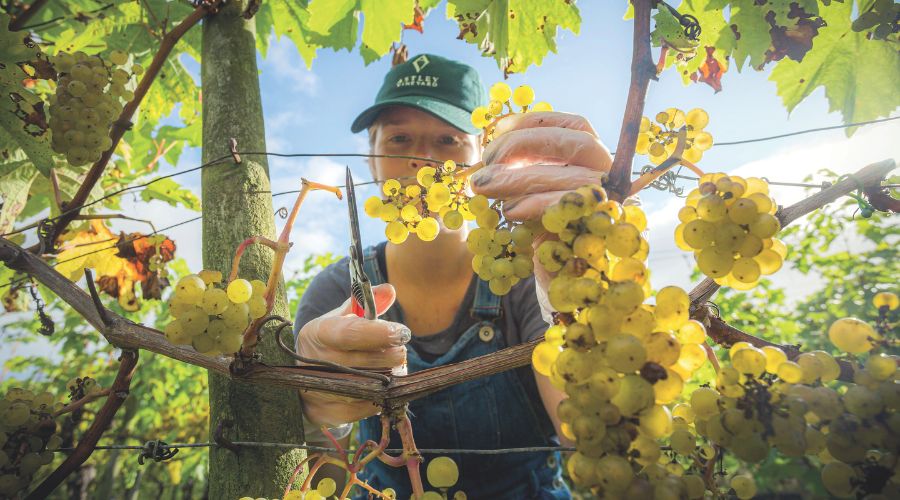
One of the oldest commercial vineyards in the UK, Astley Vineyard was established in the lush Severn Valley in Worcestershire in 1971 and features some unexpected grape varieties. Editor Rachel Hicks spoke to its current owners, the Haywood family, to find out more.
Astley Vineyard is currently owned by the Haywood family – Tim is responsible for the vineyard, his wife Bev manages the tourism and retail, their son Chris is the wine expert and winemaker, while their daughter-in-law Matleena works in the vineyard and manages the accounts.
Originally established in 1971 by the Bache family, the vineyard is one of the oldest commercial estates in the UK. When it was planted, Astley Vineyard was widely regarded to be the most northerly vineyard in the world.
Michael Bache was a solicitor who loved wine. He did meticulous research, and chose a range of varieties suited to the climate in the Midlands. After the Bache family retired in the early 90s, Astley was bought by Jonty Daniels, an experienced farm manager.
Over the next 24 years, he and his wife professionalised the viticulture, and turned Astley Vineyard into a well-regarded wine producer before retiring to Thailand, where Jonty passed away in 2024.
The Haywood family bought the vineyard as a going concern in the summer of 2017, with the idea that it would be a retirement project for Tim and Bev. While they had lived in the area for over 20 years, Tim had been commuting to London in his role as CFO of a global construction business – fed up of the rat race, they wanted a change.
At the time, Chris was also living in London, working at Harvey Nichols in Knightsbridge gaining experience and studying for his WSET wine qualification.
The estate is just over 4ha in total, of which 2ha is under vine, while a wooded valley with spring and stream bring diversity to the vineyard.
Astley was originally part of a larger woodland before being turned to agriculture in the late 18th century. For much of the 19th and early 20th century it was a cherry orchard owned by a charity for the benefit of the poor in nearby Bewdley.
Then the Baches bought the land, built themselves a house complete with tennis courts and outdoor swimming pool (both now gone), before grubbing up the orchard in the 1960s in preparation for the vineyard planting.
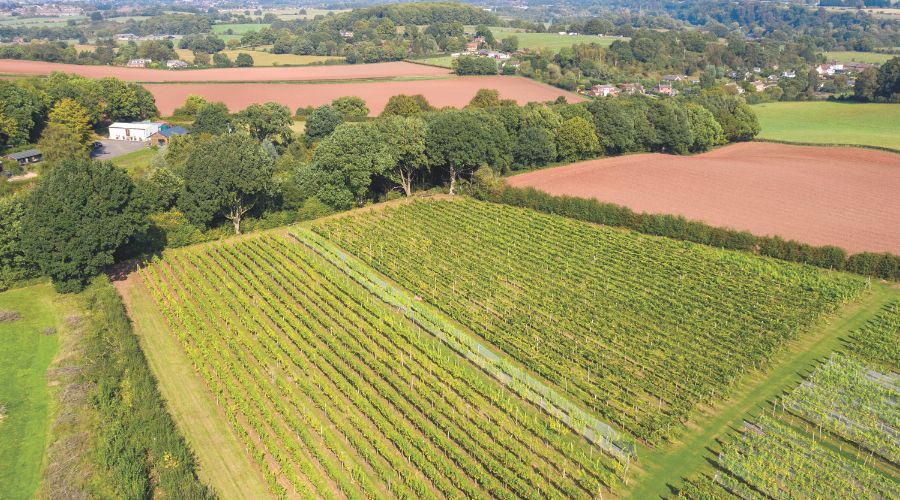
Intriguing varieties
There are four main grape varieties split fairly evenly over the two hectares – Bacchus, Madeleine Angevine, Siegerrebe and Kerner. There are also tiny quantities of Sauvignon Blanc and Pinot Noir.
The Kerner vines are the original ones planted in 1971, making them among the very oldest in the UK and they are listed on the Global Old Vine Registry – as are the Madeleine Angevine vines, which are over 45 years old.
No other vineyard in the UK grows commercial quantities of Kerner. This uncommon vinifera cross of Riesling and Trollinger ripens late (mid-October onwards) and ages well. When picked early, it has a simple elegance that is similar to Riesling or Pinot Blanc. When ripe, or picked late, it is far more opulent, rich and aromatic; like Chenin Blanc or Viognier.
When it comes to its tricky management, Chris says: “Due to its immense vigour, Kerner is managed differently in our vineyard. The crown is raised high, and the growth is trained downwards to expend excess energy. Each unique Kerner vine takes significantly more time to manage than all our other varieties.”
Planted in 1996, Siegerrebe is a notoriously hard-to-establish variety that seems to thrive in Astley’s vineyard. Chris explains: “A cross of Madeleine Angevine and Gewürztraminer, it is a blush, early ripening variety that is immensely aromatic. When picked early, it shows lychee and passionfruit. As it ripens (and with extended maceration) it shows strawberry and potpourri.
“We can also leave this variety on the vine, and pick it extremely late to make our Late Harvest (when the vintage allows).”
Harvest is entirely done by hand. “We have a lovely group of friends and family to call on,” says Chris. “We wait for appropriate ripeness and a sunny day, and aim to pick around one tonne in a morning. We all have lunch together once the tonne is picked, then the family go to the winery to process the grapes.”
This means the grapes only have to travel 100 metres for processing and bottling.
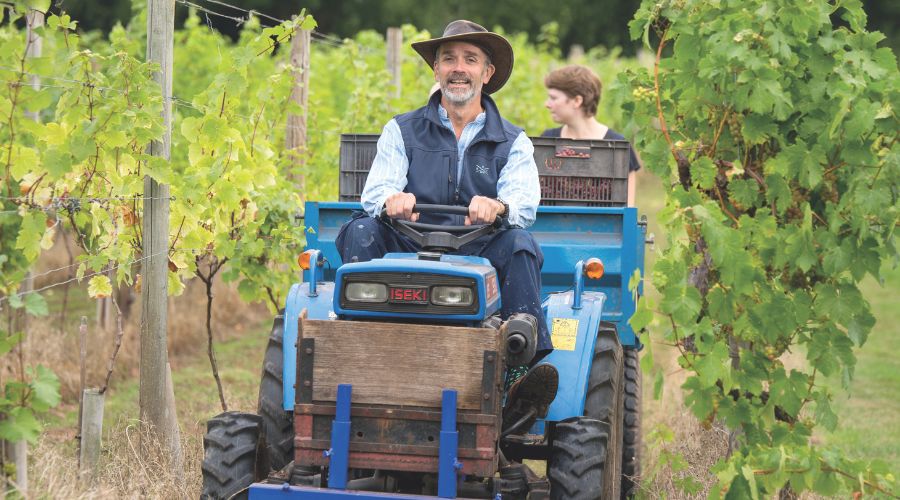
Yield and canopy management
Being relatively northern and in the West Midlands, the average yield varies significantly. In the last five years, due to frost events and some wet springs/cold autumns, the average yield is seven tonnes.
Having very old vines also restricts production, Chris points out. “Our old vines are special and produce characterful wines. Yields are lower per hectare, but we see quality over quantity as a strength. We must occasionally replace dead vines, but we are committed to nurturing the existing plants.”
All vine management is done by the family, led by Tim. Pruning starts as soon as Christmas is over and takes around five weeks at a constant rate.
The majority of the vines are on a double guyot system, but a few rows are spur pruned. Tim says: “We are gradually converting our Sauvignon to spur pruned. In January 2023 we hosted a pruning course organised by Plumpton College and led by Italian consultancy Simonit & Sirch.
Their emphasis on ‘Gentle’ pruning with consideration of sap flow and pruning scars transformed our methodology and has significantly improved the health of our old vines.
“Shoot selection is meticulous to ensure our vines are not overburdened. Then canopy management is the biggest task of the year to ensure good airflow around the developing grapes. We top the vines with a hand-held hedge trimmer, and we vigorously leaf strip during August.”
Overcoming challenges
2024 was a difficult year for most vineyards, and the same was true for Astley. “A very long cold spring delayed the start of the season, so we were playing catch-up all year,” says Tim.
“But, unlike other vineyards, we did not suffer significantly from disease due to a proactive spraying programme and support from an expert from Hutchinsons. There were plenty of bunches, but individual berry size was noticeably smaller than usual resulting in less juice at press.”
Being in the west of England, rain can be an issue in some years, producing high humidity levels and resultant risk of mildew. However, Tim points out: “Our policy is to spray only as needed and it is definitely the case that prevention is more effective rather than cure. We are very proactive in canopy management to minimise risk.
“We initially tried fully organic management of the vineyard but it is extremely time consuming and ultimately ineffective for our site.”
Boosting biodiversity
In 2023, the Haywoods were approached by the University of Worcester to take part in a study looking at perennial wildflower planting in vineyards to promote biodiversity. “We planted one in three of the alleys with a special flower mix which is now well-established and needs only a couple of specific height mows a year as maintenance,” says Chris. “There has been increased numbers of birds and insects onsite
and is also ridiculously pretty!
“We have counted 62 different birds visiting or living on the estate. And a bat survey listed five different species using our woodland.”
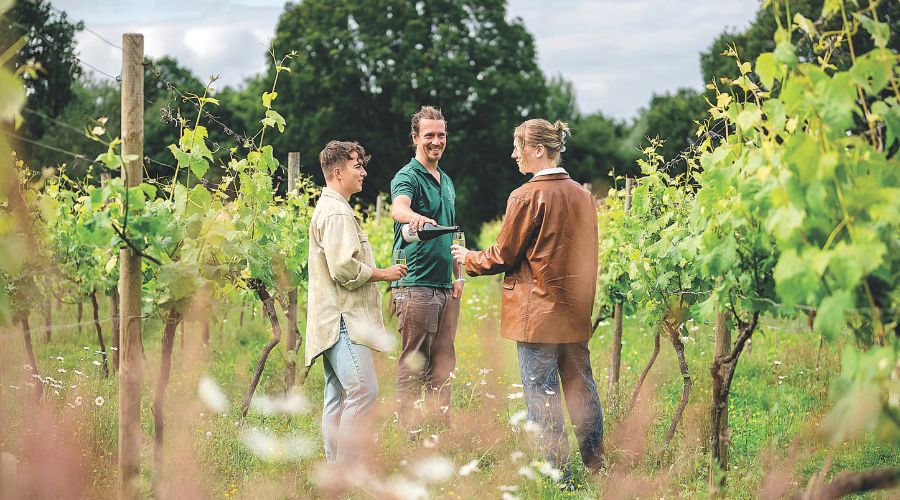
Winemaking
“When we bought the estate, the wine was being made by third party contractor Three Choirs in nearby Gloucestershire,” shares Tim. “They had done a great job for Astley and helped win numerous awards. However, we felt we wanted more control over the whole process and that it would make long term financial sense if we had our own winery, and allow us to make more micro decisions about winemaking.
“The problem was, none of us had ever done it before. So we enlisted the help of winemaking consultant Simon Day to create our own bespoke winery, which formally opened in 2018. It was part funded by EU Leader grants and is designed to cope with our grapes only.”
Tim and Bev are obviously very proud of their son. “Chris has done a remarkable job in the winery with a clear vision, meticulous care and an understanding of Astley’s grapes.”
Astley makes all its wine from its own grapes, although occasionally has to supplement its small quantity of Pinot Noir, buying grapes from a neighbour to make a limited amount of red. The family’s goal is single estate wines at all times.
The vineyard’s output is predominantly white still wines, although they do also produce a small amount of sparkling. “We also make limited amounts of our own vermouth, using spirit from a local distillery and a variety of botanicals,” explains Chris.
“We combine the spirit and botanicals into ‘teas’ which we use to flavour and strengthen the base wine. Finally, we now make a ‘piquette’ – after pressing grapes for wine, we rehydrate the waste skins with water, press again, then bottle ferment the liquid. It creates a cloudy, dry refreshing drink at only 5% ABV, similar to craft cider [this process was made legal in the UK in Jan 2024].
“Our sparkling wines are mainly made with Kerner grapes, but we have previously made a sparkling Bacchus. We use the Traditional Method only, all disgorged and inoculated by hand – a time-consuming process!
“Our most popular sparkling is called Freya. It’s made from Kerner and is usually ‘SEC’ in its sugar levels – halfway between dry and sweet. It makes it approachable and fun to drink – a great celebration wine.”
For the team, bottle and corkage procurement is always a concern, with Tim pointing out that the lead times have become very long since Brexit and Covid-19. “But we are good at long term planning and have yet to be tripped up!” he smiles.
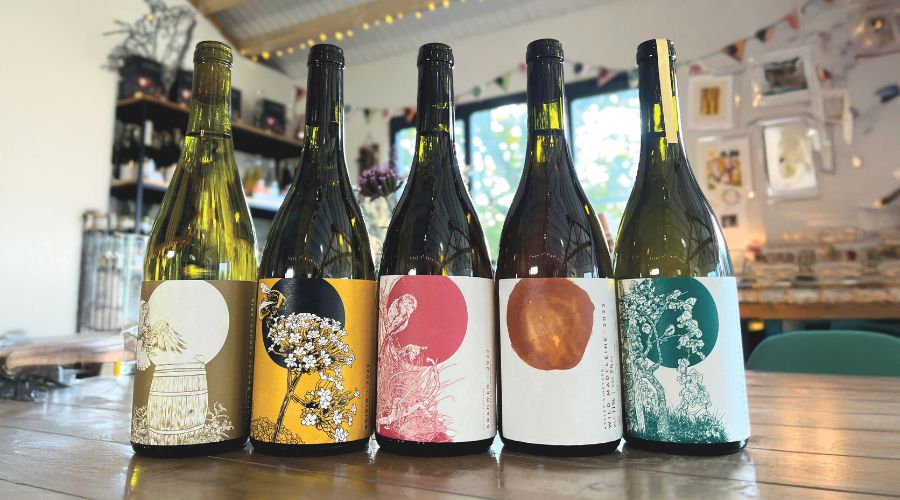
Astley Vineyard sales and tourism
Almost all Astley wine is sold direct to the consumer, through the site shop, online store and on tasting tours. “We do sell to a few farm shops, local pubs and restaurants but in small amounts. We will also supply a few Michelin-recommended restaurants who want something unusual on their tasting menu – for example, Forest Side in Cumbria is currently featuring our Pinot Noir,” shares Chris.
Tourism is a key element of the business and has been developed significantly since the Haywoods took over the business in 2017. “We built a tasting room within 12 months of moving in which acts as a shop and place for tours and events,” says Chris. “We run tours for up to 20 people once a week throughout the summer – these are usually sold out and we have won several awards for our tourism offer. Vouchers are important for tours – they are a popular present, many being sold in the pre-Christmas period.
“Having visitors is important to us – we can tell our story, let people understand what we do here, and they try our wines. We have a motto – ‘they buy what they try’. And selling direct avoids having to give hefty trade discounts.”
In summer 2024, Astley installed two shepherd huts into the vineyard for weekend stays – another source of income and this attracts visitors from further afield. Funding through Malvern Hills District Council helped this project financially.
Brand identity
“Our label designs are very important to us and make our bottles instantly recognisable,” Bev Haywood comments. “We invested in a rebrand as soon as we arrived in 2017 using local agency WeAreBeard in Worcester to bring our ideas to life. The modern yet illustrative nature designs are distinctive and eye catching.”
Machinery
Describing themselves as a ‘micro business’, there’s little need for lots of big machinery. The vineyard operates one old Iseki tractor for pulling a trailer, and a three-year old Kubota tractor which was bought new from Ron Smiths in Worcester for spraying and occasional flail mowing.
Both are very narrow to cope with the tight alleys, and a ride-on mower is used for keeping the grass down. But Chris highlights one particularly useful tool: “One of our favourite bits of kit are the rechargeable Kebtek pruning secateurs – good value for money, light weight – perfect for pruning the vines!”

The future of Astley Vineyard
“After seven years of project after project, we are consciously trying to rein ourselves back,” Chris comments.
“We’ve made a lot of changes to the site and made a lot of investments in buildings and machinery. Buying the estate was supposed to be a retirement project for my parents, but it has turned into a much bigger undertaking than originally thought. The vineyard is now on the market so they can retire properly, but we know it is likely to be some time before the right buyer comes along.”
Tim adds: “Chris is 35 years old so has a great wine focused career ahead. He’s already doing some consultancy work and has done judging for the IEWA competition. Until the right buyer comes along, we will carry on as we are, enjoying the work and the lovely place we live in.”
Find out more about Astley Vineyard.
Read more grower profiles.
